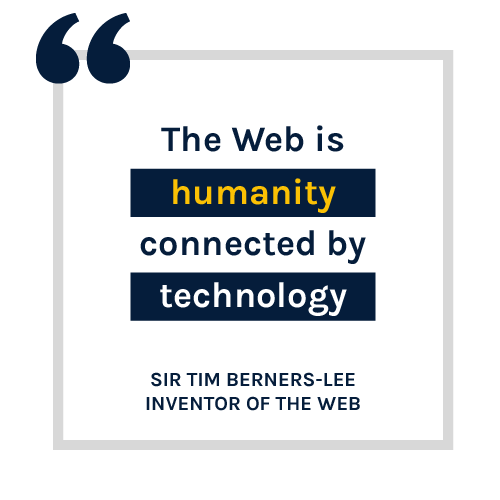The World Wide Web Consortium at 27: a guiding star for the future of the web
Twenty-seven years ago, on 1 October 1994, Tim Berners-Lee launched the World Wide Web Consortium as the next step in the evolution and support of the Web. Quoting from the proposal:

“The web allows human communication and cooperation by sharing knowledge, and opens this to ordinary people who need no technical skill. […]
At the same time, companies which are becoming increasingly committed to the web as a way of working and doing business are calling for a central body to define the web, ensure its stability and smooth progression through continued technological innovation.”
True to Tim Berners-Lee’s vision
Much as Tim’s original vision for the web as a global information sharing space has proved visionary for the web, so does his original design of the Web Consortium.
The aims he described for the Consortium have stood the test of time and his vision is a guiding star: after 27 years, we continue to act as a primary point of contact for those interested in the web; coordinate the development of the web standards that undergird the web; promote the use of the web in new domains; aid especially the less technically developed countries in using the web for the rapid transfer of knowledge, diffusion of culture and as an economic enabler.
Please bookmark and read our latest report to see our work in context. The next version of our Strategic Highlights document will be published in a few weeks.
Thousands of specifications to weave the web
Since October 1994, W3C published 446 Recommendations (final standards), part of a total of 8367 different classes of technical specifications.
These technologies power the web and are made robust by our focus on interoperability, security, privacy, web accessibility, internationalization. The web of 27 years ago still works, just as the web now will work 27 years in the future. As W3C’s Dominique Hazaël-Massieux mentioned recently: “That's part of the promise of web standards. It's amazing to think that we can can still load the first website in any of our browsers without any challenge. The confidence that business can have is that part of the business we're in at W3C is building to last."
A visionary web community
One unusual aspect of the Consortium is that many of those who were at W3C at its start are still in the staff (among others, the “father of CSS” Bert Bos and “father of SVG” Chris Lilley), part of our membership or of our larger community. This community is global and ranges from new coders to experts who have contributed to the building blocks of the Web.
Since then, many more have joined the ranks of web standards, from around the world and more diversity means better representation, which leads to better and more inclusive web standards design. The staff, members, and community who have given their time (sometimes decades of their time), expertise and vision, are unique in their efforts to together make the web and the world better.
Tim Berners-Lee once said: “The Web is humanity connected by technology.” The specifications we write are blueprints for the web, which in turn become web pages available in hundreds of languages and accessible to people with disabilities; video conferencing with colleagues or family; beautiful graphics, fonts, videos, games, VR, movies; online shopping; music, photos or works of art. They are the power of data, connected cars and connected cities. They are people connecting, sharing and learning.
As we celebrate this anniversary today, we are grateful for the incredible energy and good will that the web sparks off. With our community, the Web Consortium continues to make the web work, for everyone.
Comments (0)
Comments for this post are closed.